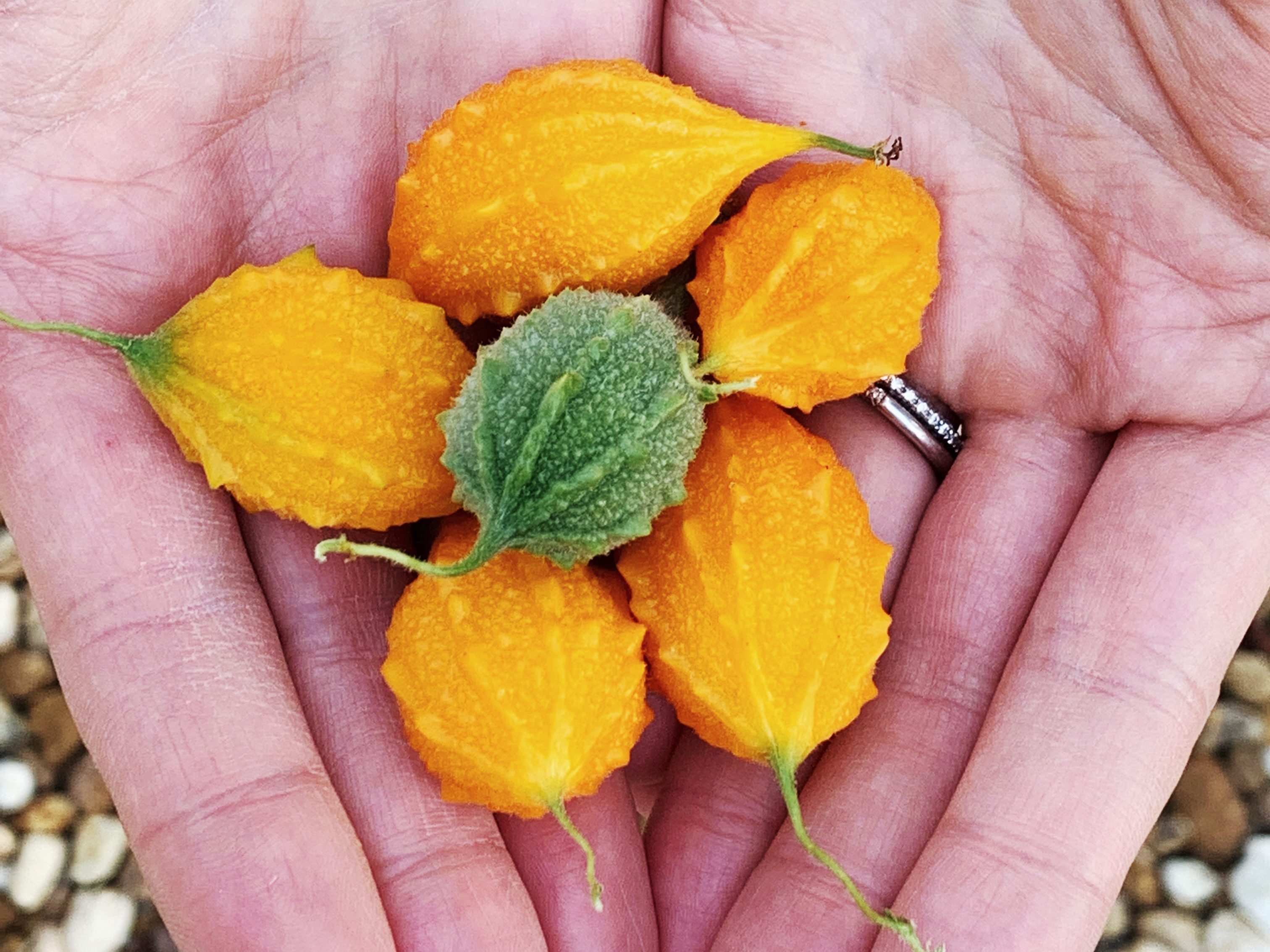
A funny thing happened on the way to the drug store…ah, this is so me. We were on vacation in the Florida Keys, and I took a short walk across the street to pick up a few things at the drug store. I stopped to admire a pretty bush with silvery leaves, and something bright caught my eye. A neon orange, spikey fruit called the balsam apple dangling from a vine. I had to know more.

When I came back from my walk, I searched the web for more info. Then, I went back to the bush and collected samples of the vine, fruits and seeds. You don’t think the drugstore would mind that I borrowed their weeds, do you? I had so many questions. What are the uses? Is it native to the US? How did it get there? Is it historic?
The scientific name is Momordica balsamina. That is only important if you feel compelled to buy seeds. It’s not an apple, and you don’t make balsamic vinegar from it. If you grew up in Asia or Africa, you might know this herb or one of its close cousins, like the bitter melon. It is used as a herb or a vegetable in some Asian and African nations, but balsam apple is pretty much unknown in the US.
It is historic though, even in the US. Thomas Jefferson grew balsam apples at his experimental garden at Monticello. I’ve read a few books about that garden. In addition to eating the leaves and unripened pods, our ancestors used balsam apple to treat wounds. Sadly, most of the knowledge about how to use it to treat wounds has been lost to time. The former president was a big fan of flowering vines, but the plant is not native to the US. It is believed to have originated in Africa.

Unique look
Balsam apples are so ugly, they’re beautiful. The vine is long and straggly. The balsam apples themselves begin life as adorable little yellow flowers, which become lumpy, warty green fruits. If left to ripen, the green fruits turn neon orange and squishy. When they open, there are three rows of sticky, wax-covered red seeds inside. You can see some of the sticky wax on my fingers in this photo.

How to use a balsam apple
Young, green fruits and leaves can been eaten raw, stewed or fried. While I wouldn’t recommend eating random vines you find growing on the side of parking lots, I did taste the leaves. They’re bitter. Really bitter. Even though I enjoy strong flavors, I am not so sure about eating any quantity of balsam apple raw. And there are some warnings…
Do not ever eat the seeds or the ripe, orange fruit. It is poisonous and can cause vomiting and diarrhea. Avoid ingesting balsam apple if you are pregnant, for fear of causing miscarriage. That really freaks me out. I would avoid balsam apples and bitter melons entirely if I were pregnant or planning to be pregnant.
Ashley at My Heart Beets wrote a funny post and recipe for the cousin of the balsam apple (even though she refers to bitter melon as balsam apple, it isn’t, but they’re close). She compares the flavor of bitter melon to a potent beer.
However, this recipe for Cassava root and balsam apple sounds pretty intriguing. Here, the leaves are used as an herb to flavor the dish than as the bitter, pungent star of the meal.

Should I sell balsam apple at my farm stand?
Referring back to the whole concept of farmstand culture, if you have a farm stand that serves people from Africa or Asia, especially India, China, Mozambique, Nepal, or Vietnam, you might consider growing balsam apple or bitter melon. Start asking your neighbors if they would be interested in this mostly forgotten herb.
When they’re in stock, you can snag a pack of seeds here. Once you grow the balsam apple vine, you should be able to harvest plenty of seeds for future plantings and never need to buy seeds again.
Considering its strongly bitter flavor, balsam apple would be a tough sell to people who did not grow up with the herb, like most Americans. It will attract a ton of attention, but you’ll have to do a ton of educating. You could try one of my recommendations to increase your farm stand income and pair a small pint of green balsam apples with a recipe. Your patrons will need more information and ideas.
Remember, once ripe, the orange balsam apples are dangerous and should never be sold. If you don’t harvest them when they are very young and green, do not sell the fruit to your farm stand patrons. I would include a warning about the risk of miscarriage, which is likely a big buzz kill for your farm stand customers.
The plant is pretty prolific. You should get a lot of unripe, green balsam apples from each vine, and, but be careful, as the residents of South Florida have discovered, the plant can become a bit invasive. It’s not hard to weed out; it’s a pretty simple vine. I’d say, oh I don’t know, chives are a much bigger problem if they go to seed.
Future of balsam apples
Once a featured conversation-starter in a president’s garden, balsam apples now grow in complete anonymity in the bushes along the drugstore parking lot. It is a rare and fascinating herb. One that deserves more study. What properties made it so attractive to our ancestors to use to treat wounds? The true benefits and risks of balsam apple vines remain mostly a mystery.
As an Amazon Associate, I earn from qualifying purchases.


